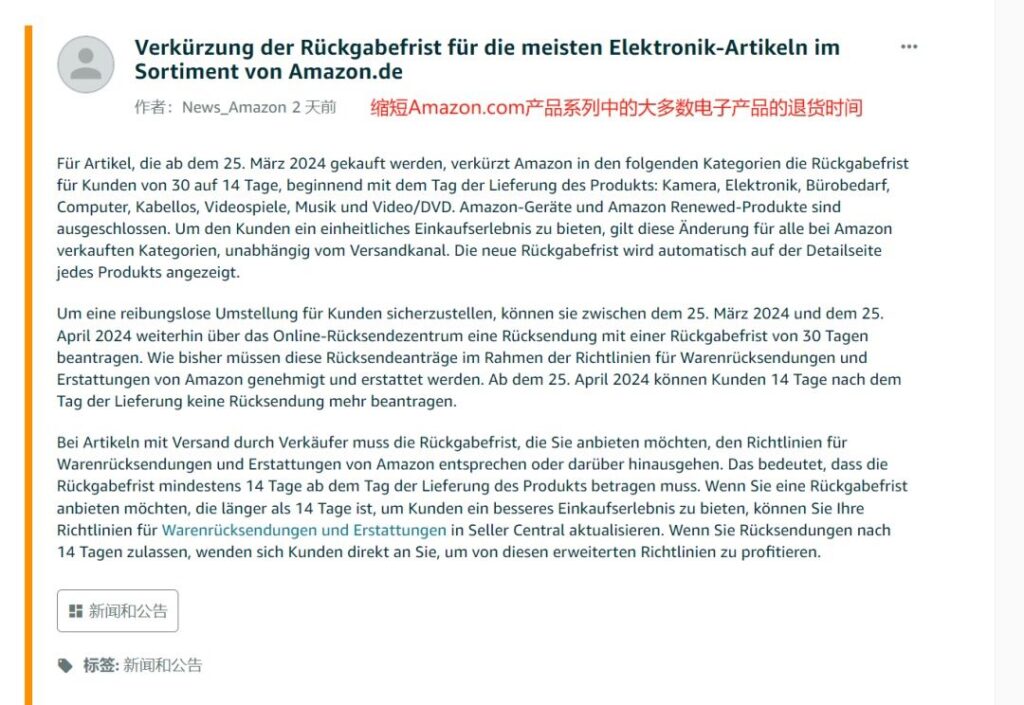Major Policy Shift: Amazon Cuts Return Window to 14 Days Across Key EU Markets
Amazon has officially updated its return policy across major European marketplaces, including Germany (Amazon.de), Italy (Amazon.it), France, Spain, and the UK. Starting June 23, 2025, multiple product categories are now subject to a 14-day return window, replacing the widely known 30-day Voluntary Returns Guarantee.

This change affects both FBA and FBM sellers, and marks a significant shift in how returns are handled—legally, operationally, and competitively.
What Has Changed?
Amazon is now fully aligning with the EU Consumer Rights Directive, which mandates only a 14-day “Right of Withdrawal” for eligible purchases.
Previously, customers had up to 30 days to return most items under Amazon’s Voluntary Return Guarantee. But as of July 23, 2025, a growing number of categories will only be eligible for the 14-day statutory return period—no more, no less.
Categories Affected by the New Return Policy:
| Previously Changed (Since 2024) | Newly Affected (From July 23, 2025) |
|---|---|
| Electronics | Books |
| Cameras & Photography | Software |
| Computers & Accessories | Toys & Games |
| Wireless Devices | DIY Tools |
| Office Supplies | Kitchen Products |
| Music, Videos & DVDs | Automotive & Motorcycle Gear |
| Video Games | Personal Care Electronics |
| Home Entertainment Devices | |
| Major Appliances |
📝 Important: All these categories now follow the 14-day Right of Withdrawal, and are no longer protected under the 30-day voluntary return policy.
Non-Returnable Products (Even Within 14 Days)
Some products are excluded from both voluntary and statutory return rights, especially when opened, used, or customized.

Return-Restricted Categories:
- Health and hygiene-sensitive items (e.g. masks, razors) once unsealed
- Sealed software/media (e.g. DVDs, games) once opened
- Custom or personalized goods (e.g. Amazon Handmade)
- Perishable items (e.g. food or fresh goods with short shelf life)
- Digital content (eBooks, downloads) if already accessed
- Services already fully performed
- Alcohol with delayed delivery and market-based pricing
- Newspapers, magazines, and journals (non-subscription)
Tip: For sellers offering these items, make sure your product pages clearly communicate these exceptions to avoid disputes and A-to-Z claims.
Why Amazon Is Making This Change
Amazon’s strategic shift reflects a growing trend toward localized compliance, operational efficiency, and fraud prevention:
- Reduces return-related costs (shipping, restocking, warehousing)
- Protects sellers from serial returners or abusive buyers
- Aligns with EU consumer laws, avoiding regulatory friction
For Amazon, it’s about sustainability and customer trust. For you as a seller, it’s about staying agile and informed.
How This Impacts Sellers (The Good & The Risky)
Potential Seller Benefits:
- Fewer impulse returns or buyer’s remorse
- Quicker inventory turnover and restocking
- Reduced refund fees and logistics costs
Potential Challenges:
- Confused customers leading to negative feedback
- Shorter window for customer support resolution
- Higher A-to-Z claim risk if return instructions are unclear
Example: A buyer in Italy receives a coffee machine, waits 18 days, and is denied a return—without prior knowledge of the new 14-day rule. That could easily turn into a dispute.
What Sellers Should Do Now – Action Plan
To stay ahead, sellers must adapt their operations and communication immediately. Here’s a checklist to ensure you’re ready:
1. Update Product Listings & Store Policies
- Clearly display the 14-day return period on product pages
- Add FAQs explaining category-specific return rules
- Emphasize “unopened/unused” conditions where applicable
2. Align Your Fulfillment Settings
- FBM Sellers: Update return addresses and processing times
- FBA Sellers: Monitor Amazon’s handling of eligible returns, especially in borderline cases
3. Train Customer Support Teams
- Use pre-written scripts for return-related inquiries
- Respond to customer return requests within 24 hours
- Create internal SOPs for edge cases (damaged, delayed, or partially used items)
4. Optimize Packaging and Descriptions
- Add A+ Content or product videos to reduce misunderstandings
- Use sizing charts and lifestyle images to minimize avoidable returns
- Include return instructions and deadlines in delivery packaging
Long-Term Strategies to Reduce Return Rate
- ✅ Returnless refunds for low-value items to cut reverse logistics
- 📩 Post-purchase education emails (setup guides, care tips) to reduce dissatisfaction
- 📊 Analyze return reasons regularly—refine product selection or fix description gaps
Final Thoughts: This Is More Than a Policy Change—It’s a Seller Wake-Up Call
The updated Amazon EU return policy isn’t just a regulatory shift—it’s a strategic signal. To survive (and thrive), sellers must double down on:
- Transparency
- Operational agility
- Customer-centric communication
By proactively adapting, you’ll not only protect your margins—you’ll stand out as a trusted seller in an increasingly competitive European marketplace.
Pro Tip: Turn this policy change into your competitive edge. The sellers who communicate better, ship faster, and reduce confusion will win in 2025 and beyond.
Frequently Asked Questions (FAQ)
Q: Does this apply to all Amazon EU sites?
Yes, including Amazon Germany, Italy, France, Spain, and the UK.
Q: What if I still want to offer 30-day returns?
You can, but you must make that clear in your store policy. Amazon now only requires 14 days for many categories.
Q: Can buyers still return opened products?
Only if they’re not in a restricted category and are still in resellable condition.




